How Has Our Relationship With Wild Animals Changed Since The Time Of Colonel Patterson
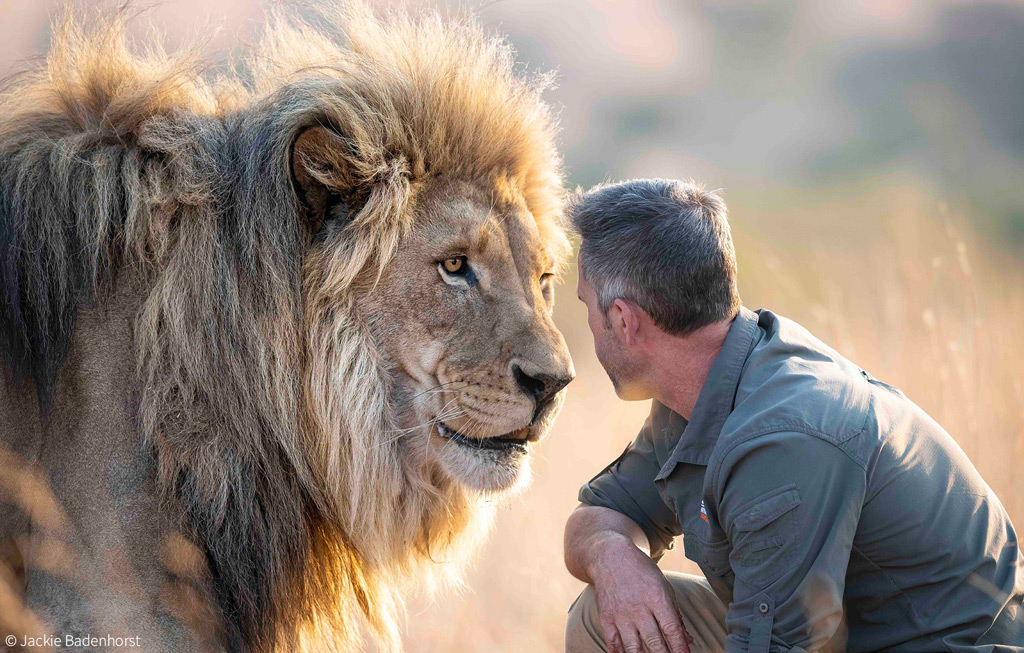
Kevin Richardson, AKA 'Lion Whisperer – some hard questions and frank replies
Kevin Richardson loves lions – to the extent that he has rescued and rehomed several. Along the way, he has congenital a substantial following and personal media brand that generates acquirement and allows him to continue doing what he loves. His public shows of affection for his tame lions have earned the wrath of those who feel that he is setting a bad case in the war against the abusive cub petting industry. Nosotros asked Mr Richardson some tough questions, and he replied with passion and transparency. This Q&A contains no bias or hidden agenda – our intention is to interrogate the facts and provide you with a meaningful background to a controversial subject area.
![]() In past years, tourists have been grossly misled most captive lions past certain commercial captive wildlife facilities masquerading as sanctuaries or rehabilitation centres. Do you believe that the SATSA guidelines in this regard become far enough in helping tourists make upstanding decisions?
In past years, tourists have been grossly misled most captive lions past certain commercial captive wildlife facilities masquerading as sanctuaries or rehabilitation centres. Do you believe that the SATSA guidelines in this regard become far enough in helping tourists make upstanding decisions?
KR: I don't think guidelines are e'er enough to influence man behaviour. This takes zero away from the guidelines; it has to do with people's choices and their desire to get, consume and deport every bit they please. The enquiring, ethical tourist has probably already drawn a line in the sand and does not need to be called to higher moral ground. When it comes to a person who is hellbent on touching captive animals? I think that private will do then regardless of any guidelines. I feel that the influence of peers and influential voices are imperative to people's choices. If someone you respect says, "Hey, that is non okay" so the person's ego is affected – a meaning motivator of behavioural change.
Tourist decisions bated, what about industry players? Accept the example of the struggling tour guide, (especially because the devastating effects of COVID-19 on tourism) whose client insists on a cub-petting experience. Will he follow guidelines or determine instead to put nutrient on the table? Don't go me wrong, having these guidelines is a valuable reference, but recently I heard someone say, "Idealism is a perfect science until information technology affects y'all." I call up sometimes those who venerate idealism are the same ones who are in the privileged position to do so. I run across this with online activists that often accept never prepare foot in Africa, they have a lot to say, simply don't empathise what information technology's like at the coalface.
Guidelines tin also be deceiving as they lure people into thinking alter has occurred. When the SATSA guidelines were released, a lot of people misunderstood them and believed that wildlife interactions were banned. This was damaging and acquired confusion and still does. The guidelines refer to "changing trends in tourism" and link to a news article that says TripAdvisor won't sell tickets for activities with wildlife interactions. A quick search volition show that you can still purchase a cub petting experience at the Lion and Safari Park on TripAdvisor, who rate the park four.5/5.0. It sounds bleak, merely I am wary of guidelines as they can be celebrated for achieving something that is not near being achieved. And so, I judge I am saying I don't think guidelines can go far enough in effecting alter because they are guidelines and can be ignored without result.
![]() Much of your conservation-based work appears to be through education, every bit described on your website. Could you lot provide salient examples of how the work that yous practice with your lions has benefitted lions in the wild?
Much of your conservation-based work appears to be through education, every bit described on your website. Could you lot provide salient examples of how the work that yous practice with your lions has benefitted lions in the wild?
KR: Education and awareness are difficult results to monitor and evaluate; however, in that location are many salient examples of how my work has benefitted lions in the wild. Most obvious would exist the vast amount of money raised through the sales of images of the lions in my sanctuary that go along to back up the work of organisations such as Tusk and WildAid to protect wild lions. Millions of Rands take been raised in the last few years through David Yarrow'south auctioning of these images, fabricated possible merely because of the relationship I have with these lions. * AG editorial annotation: We accept confirmed with TUSK and David Yarrow that this statement is factually correct
Although we don't publicise information technology much, my work supports scientific research that benefits wild lions and other predator cats in the wild. The power to access the lions without anesthetising them has opened up heady and enlightening scientific results. For example, the Section of Wildlife in Botswana put frontward a motility to reduce buffer zones between the Khutse Game Reserve and human settlements to allow more space for rural farming. Conservation researchers were concerned, having already noticed the reduced recruitment rates of wild lions in this area due to increasing pressure from human being encroachment. They objected to the motion explaining that proximity to humans was causing excessive free energy expenditure resulting in wild king of beasts population decline. Although the researchers had collected a lot of information on these wild lions, the authorities asked for proof and researchers needed a comparative model to bear witness their theory. Nosotros placed collars with accelerometers and GPS trackers, that had been adult by the University of Oxford's WildCru team, on the lions in my sanctuary and were able to apply this to create energetic models. Each day of the research, we were able to collect saliva swabs and faecal samples to further ascertain a model. This study was only possible due to my relationships with the lions. Now, there are models to help not just lions but other predator cats in the wild. The outcomes also provided information that can help NGOs to tackle carnivore coexistence bug on the ground.
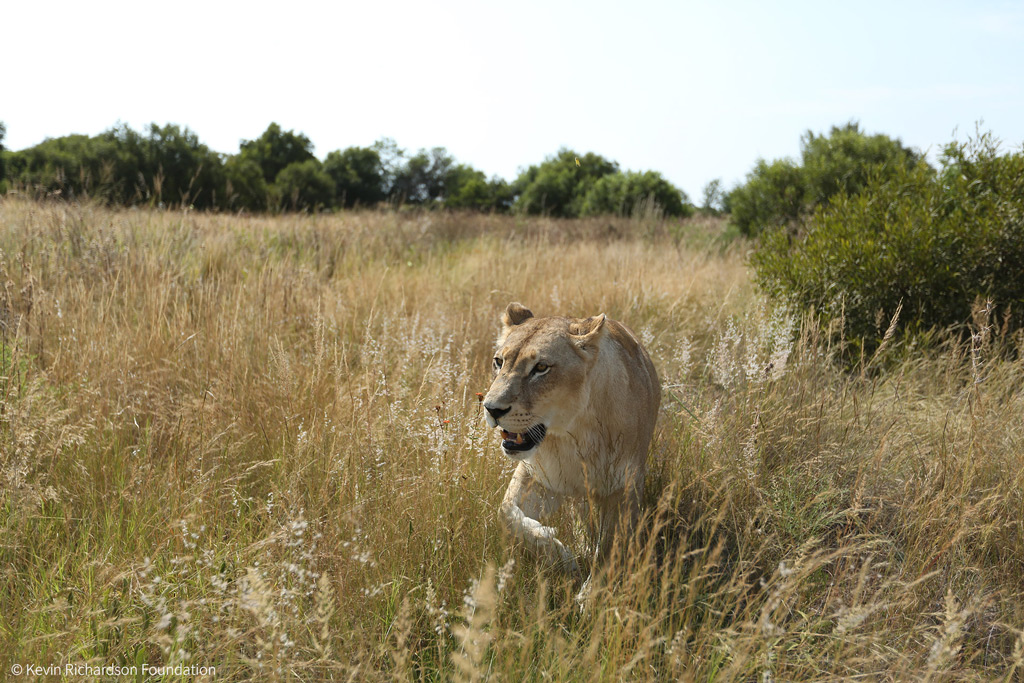
Some other incredible written report we facilitated was the oxytocin trials we performed final yr with researcher Jessica Burkhart that proved benign for wild lions. As habitats compress and wild fauna direction becomes more than demanding, there is an increased demand for relocation of wild fauna. This can exist stressful and disrupt natural bonding behaviour for lions. Vets thus administrate heavy tranquilisers in an attempt to stave off the aggression of translocated lions and help them bond and settle into new environments. Oxytocin is a naturally produced hormone that promotes bonding behaviour (such as caput nuzzling in lions). Administering a natural hormone tin can decrease the side furnishings of drugs currently used (and as well assist with healing and hurting in captive lions). Jessica performed oxytocin trials on the sanctuary lions to assess the benefit of using oxytocin administered intra-nasally. The trials couldn't exist measured on lions that had been darted and were asleep, and it was easy and gentle for Jessica and me to administer the nasal spray on the sanctuary lions. Cats traditionally do not enjoy being sprayed in the face, but our lions savour the stimulation of me coming in to spray them with citronella and rub wing ointment on their ears. They cooperated and enjoyed this scientific trial. Information technology was amazing to picket fifty-fifty our grumpiest lion rolling around, purring happily and enjoying the effects of "the beloved drug". This inquiry has meaning implications for improving interventions with wild cats (and treat convict cats). This specific oxytocin projection was referred to past king of beasts practiced Dr Craig Packer as "one of the beginning studies washed in captive animals with real potential to take a direct bear upon on wild relatives."
* AG editorial note: We have confirmed with Oxford'due south WildCru squad likewise as Jessica Burkhart that this inquiry has been conducted every bit stated. Neither study has been published yet.
Besides scientific research, my piece of work as "the King of beasts Whisperer" has enabled me to launch a nonprofit organization – the Kevin Richardson Foundation. Our foundation has helped protect the wild lions of Namibia through supporting the work of the Namibian Lion Trust (formerly known as AfriCat North). For two years we take helped fund their Lion Guardian Programme which protects communities' livestock from roaming wild lions and thus decreases man-wildlife conflict. Nosotros also contribute to their schoolhouse's education programs in these highly remote areas. Our foundation also supports the University of Pretoria's Carnivore Working Grouping and accept provided finishing funds for projects that need additional support to consummate. We want to do much more in this space, just we are a fledgeling organisation and still in our infancy.
* AG editorial note: We have confirmation of proof of payment to both the Namibian Lion Trust and the University of Pretoria.
Less salient, but perhaps more pertinent, is how I accept used my platforms to speak to problems facing both wild and captive lions. Drawing a concrete correlation betwixt TV, films and new media and the outcome on the subject (wild lions) is difficult yet worth because. Our show "Deadly Predator Claiming", created with Smithsonian Network and featuring renowned scientists Dr Craig Packer and Dr Christine Drea, revealed the cognitive abilities of hyena and lions. This material is 1 example of how my piece of work has helped changed worldwide perceptions of these creatures from "vicious beast" to understanding how emotional, smart and sentient they are. When people love something, they want to protect information technology. My shows accept besides done a lot to foster worldwide dearest for the hyena, an animal widely demonised through story narrative such as Disney'due south "The King of beasts Rex". Story, although also challenging to measure, is a powerful educational activity tool. Simply look at the work of the Born Costless Foundation – without George Adamson and Elsa the lion's story, this organisation wouldn't exist.
I take been supporting Painted Dog Conservation Inc. for several years and accept travelled to Australia 3 times and done 12 speaking events for them – which helped raise AUS$300,000. These funds have helped protect carnivores in Zambia, by funding the purchase of vehicles, radio collars and telemetry equipment, and building rehabilitation facilities.
*AG editorial note: This was confirmed in a argument from Painted Dog Conservation Inc.
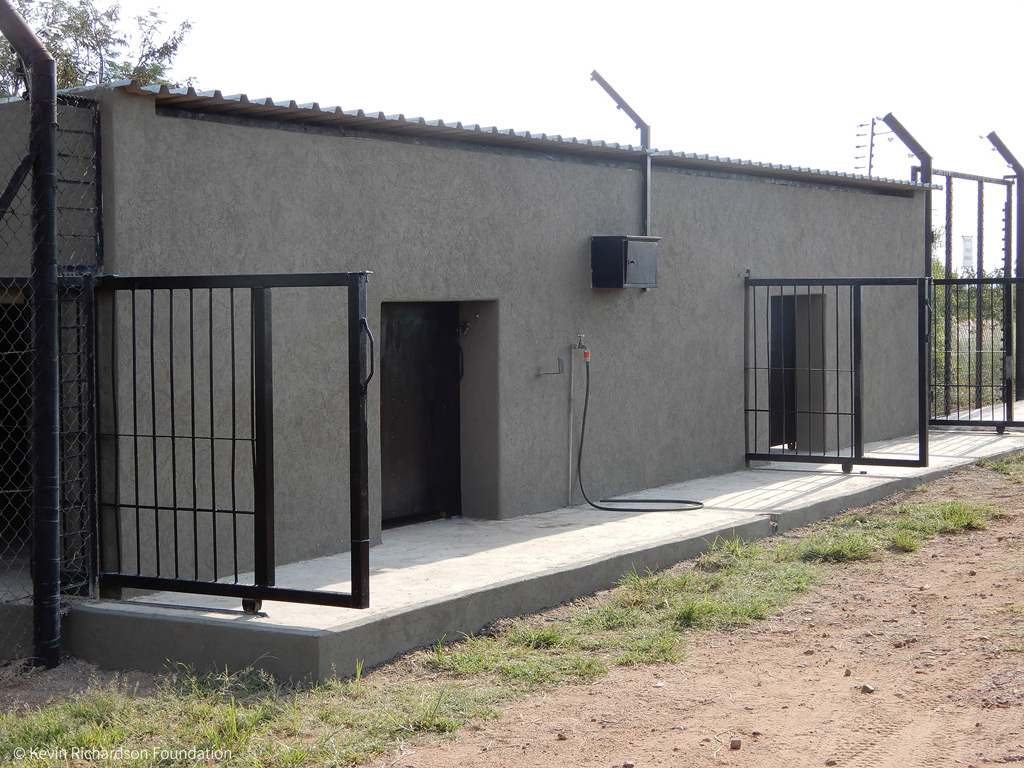
![]() In that location are studies (an example tin exist institute hither ) that have been conducted that suggest that the bodily and statistical educational value of captive wild animal centres is negligible. Do you lot disagree with these findings?
In that location are studies (an example tin exist institute hither ) that have been conducted that suggest that the bodily and statistical educational value of captive wild animal centres is negligible. Do you lot disagree with these findings?
KR: I do disagree with these findings, equally illustrated in my respond in a higher place. Furthermore, information technology'south problematic to use an isolated study to cast a internet over all captive wildlife facilities. The in a higher place study is focused on zoos, specifically 1 zoo in Finland. I don't particularly like seeing certain species in zoos, only regardless of i's views on zoos, I am surprised when people are willing to put certain wild animals sanctuaries and rescue centres in the aforementioned category as retrograde zoos in Europe.
The higher up study deduced there are no positive behavioural outcomes for visitors observing animals in captivity. That may be the instance in this instance. Yet, what should be said of respected sanctuaries such equally Paul Hart's Drakenstein Panthera leo Park, 4 Paws' Lion's Rock and Born Free's Shamwari, Lizaene Cornwall and Catherine Nyquist's Panthera Africa, which all have tours where educational information is given out? It is ofttimes these engagements that outcome in high-value donors or bequeathments that sustain the work they do. Are big donations from visitors not positive behavioural outcomes? Surely that is all the public can do to assist wild fauna conservation efforts?
A day in our sanctuary is non what some may imagine – no ane is wondering around randomly taking selfies with animals like in zoos. We have three guided tours per week, and these guests are driven in a game vehicle while provided with a large swathe of educational information well-nigh where the animals came from, how they are cared for, the captive lion convenance manufacture, canned lion hunting, and raising awareness about the plight of lions in the wild and what can be done to help them.
Small groups of volunteers are working in the sanctuary. Information technology's not glamourous work but is meaningful engagement, and we endeavour to open up their minds to the challenges of looking after convict predators and the complexities of conservation today. We accept many return volunteers. Many of our volunteers have gone on to study nature conservation or veterinarian scientific discipline. The same can be said for some of our online supporters. We get thousands of messages from teachers, young students, artists and business organization owners who relay that, what they have learnt from our channel has changed their perspectives on lions. They are upset and shocked near canned hunting. Some write to us and say they are ashamed that many years ago they naively had a cub petting experience in South Africa, and they want to make upward for it somehow. These individuals are doing presentations in schools, speaking to their peers and campaigning in their hometowns for lions. We have so much evidence of this it is difficult to aggregate.
![]() One of your foundation's listed aims is the purchase of land to increase that available for wild lions. Has whatsoever been purchased and, if so, where? What plans do you have for farther country purchase?
One of your foundation's listed aims is the purchase of land to increase that available for wild lions. Has whatsoever been purchased and, if so, where? What plans do you have for farther country purchase?
KR: Yeah. We are in the last stages of buying 1,200 hectares of wild fauna habitat on the southeastern corner of the Dinokeng Big V Game Reserve in Gauteng. The foundation will protect this country in perpetuity every bit function of a wider reserve that is supported by our authorities. In Due south Africa, protected areas are surrounded past private landowners who tin can utilize the country still they desire. Then, you lot have wildlife habitat surrounded by agricultural farms, hunting farms and even cub petting and breeding facilities. For this reason, it is essential to, wherever possible, buy back this habitat, open up it up to the wider reserve and safeguard these expanded swathes of wild animals habitat. This is a key approach that needs to be engaged in Due south Africa.
We are currently transforming a sometime commercial army camp on this state into an education centre, which will exist the base of our work with the rural communities surrounding these areas. These are the communities that resort to wildlife snares and poaching for survival. Recently a wild male person lion was killed in a snare of this kind, in Dinokeng. The land has also been poorly managed and needs a lot of input to restore habitat wellness. We are committed to ensuring this happens, starting with consulting top scientists who know the area well. The work will keep, even when all the lions in the sanctuary laissez passer on. We take plans to make the enclosures nosotros have built available to serving the rehabilitation and release of injured or transitory wildlife. We volition not be accepting any permanent 'rescues' as nosotros appreciate the psychological and physical needs that large cats crave in captive environments which is so much more than a few acres of land, nutrient, water, shelter and a couple of enrichment programs. Furthermore, as funds become available, nosotros have plans to farther expand the reserve to the north, as well as look at protecting key tracts of country where the need arises. You demand money to buy and adequately maintain state, then we will do the best we can.
![]() As a public figure, can you lot give examples of how you have used your influence to campaign for more stringent legal control over captive wild animals facilities?
As a public figure, can you lot give examples of how you have used your influence to campaign for more stringent legal control over captive wild animals facilities?
KR: First off, I am non an activist dedicating my energy to legal campaigns. It's not who I am, and I take a sanctuary to run. A few years ago, before the foundation was launched, we attempted the legal route of addressing the lion bone quota event. We employed the services of a prominent ecology lawyer, merely the legal avenues suggested were limited and across our fiscal scope.
Some examples of using my influence are the many interviews I've done. One of notable interest was the interview with CBS hr when I revealed my thoughts about the captive lion breeding industry and canned hunting. During this program, information technology was exposed that the Lion Park (it is no secret that I started my career there) had sold lions to canned hunting facilities for several years. This was ane of the highest watched segments in hour' history and viewed by an audience of twenty meg Americans. This is a pregnant demographic to brainwash on the truth around captive wildlife facilities and canned panthera leo hunting.
Later realising quickly that i can but play to their strengths in this challenging campaign, I decided to take reward of mine – which is achieve. I can't be the messiah of lions, but I have e'er been willing to put forward the piece of work of activists and partner with them in helping them go reach. I would like it on tape that I want zero more than than to utilize whatever influence I accept to support the efforts of those who are committed to this entrada. Last year we offered completion funds to some documentary filmmakers who were producing an exposé on the panthera leo bone industry, following on from the documentary "Blood Lions". We excitedly offered distribution back up through one of our foundation's contacts in the television landscape. Nosotros also offered to show the film on my channels, reaching over 2 million people. Although the producers were excited at the prospect, one or several of their other funders refused to work with us. And then, my influence and reach are being actively turned down past some 'conservationists.' These are oftentimes the aforementioned people who merits to prioritise garnering worldwide pressure to campaign for stringent legal reforms to improve the lives of captive lions. Myself and the Foundation are largely excluded from coordinated efforts (such every bit petitions and statements) of lion charities, even though we accept considerable reach and influence. I am not angry; I am sad. Last year we offered funds to a charity that trains impoverished, rural children in wildlife photography and career choices. Nosotros also indicated our interest in paying for the tertiary education of one of their top students. The charity turned us down because i or more of their board members refused to partner with me. I can just assume this was due to my relationships with the lions. This… is really distressing.
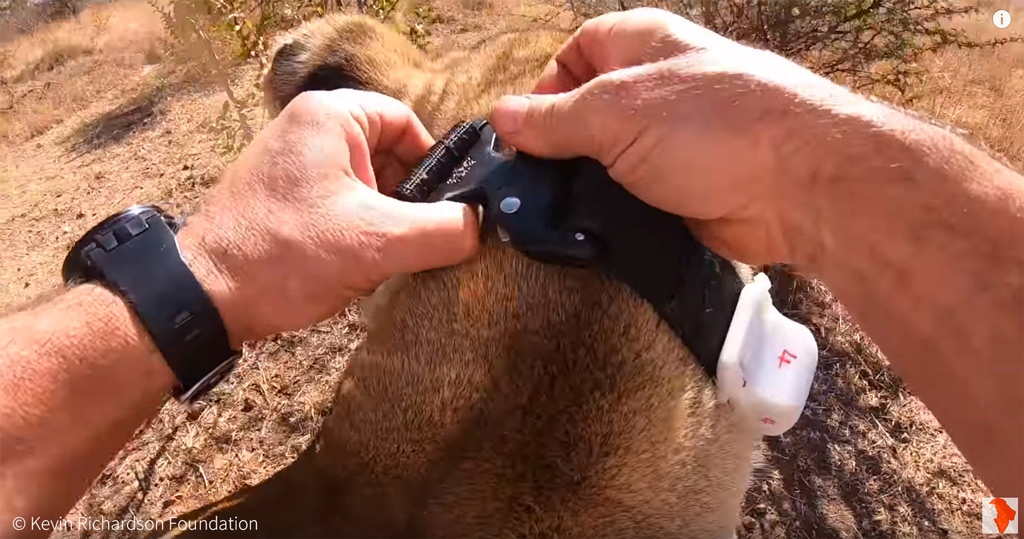
We have attended the Global March for Lions and attended the 2018 Parliamentary Colloquium on the Captive Wildlife Industry. I try to stay abreast and back up these campaigns, but it has been years now that the government is equipped with the knowledge and consequences of the country's lack of regulation, and they take done nothing. Like most people who campaign for the welfare of lions, I sometimes battle to envision an effective way to bring legal reform when the system is primarily designed in a way that the emotional and physical wellbeing of the animal are neglected. We are dealing with a regime that has a deep and systemic divergence in how wildlife is inherently perceived in value, in a country whose priorities are 100% economically driven.
I became involved with the film "Mia and the White Panthera leo" considering I couldn't see any tangible effects coming from the legal campaign. What I perceived is that I could assist in agitating a more substantial international public into understanding what is going on in South Africa, and reach audiences that had otherwise never been reached before. This film, which delivers the sordid reality of the canned hunting industry through the palatable platform of a family unit fiction moving-picture show (based on bodily events), was viewed by over 4 meg people in theatres solitary, and many more millions via VOD platforms such as iTunes, Google, Netflix and Amazon. The response to the picture was, and still is, overwhelming. The response is as well sobering when y'all realise the world doesn't know what canned hunting even is. The film is fostering worldwide condemnation of the industry every bit a whole. Daze-documentaries do not have this reach, especially to new audiences, and I consider this film as critical to expanding the campaign to a broader audience and the next generation. Talking about the side by side generation, the story of "Mia and the White Lion" is at present being turned into a 50 episode animated children's series for ages 4-8. To teach such a formative historic period group about lions and the horrible globe they be in, means the real narrative of lions (non the Disney version) is getting fixed in the minds of the side by side generation. Possibly this will help bring legal reform?
![]() What is your response to those that merits that by interacting with your animals, you are encouraging members of the public ignorant of the context to participate in such interactions and thereby are stimulating the need for such facilities?
What is your response to those that merits that by interacting with your animals, you are encouraging members of the public ignorant of the context to participate in such interactions and thereby are stimulating the need for such facilities?
KR: The rationale behind statements like this amazes me in its simplicity and banality. Does watching Formula 1 result in people going out and driving at 200mph? Does watching presenters on National Geographic Wild, capture and play with dangerous snakes, stimulate the demand for snakes being kept as pets? Maybe for the one or two lunatics out in that location, merely most people have a operation brain. The demand for petting small, cute animals has e'er existed. Lion Park began in South Africa in 1967; I was born in 1974. If I had never met ii lions dorsum in 1998, or if I had terminated my relationships with the (fully grown) lions in my care, would the demand take slowed down? I don't retrieve so. In that location is something inherent in human nature that wants to touch on, cuddle and nurture something small and cute – information technology's congenital into our biology. The problem with cuddling king of beasts cubs is not the act itself; it's that it results in something more horrific for the animals when they grow bigger. The need always existed and will proceed to exist until outlawed.
My other issue with the above argument is that some activists and organisations similar to tar everyone with the same brush, casting a net over all interactions, as if nosotros alive in a blackness and white globe. I find the to a higher place premise deficient. It also does non accost the fact that historically, and indeed today, the back up and dear of wildlife species accept been advanced by the up-shut relationships some humans take with animals. I grew up inspired by the works of David Attenborough, George Adamson and Steve Irwin, did this outcome in me wanting to interact with wild animals? No, my relationships and interactions began past a chance opportunity given to me as a immature and naïve human. I do, however, credit them with the respect, passion and dearest I have always brought to my piece of work.
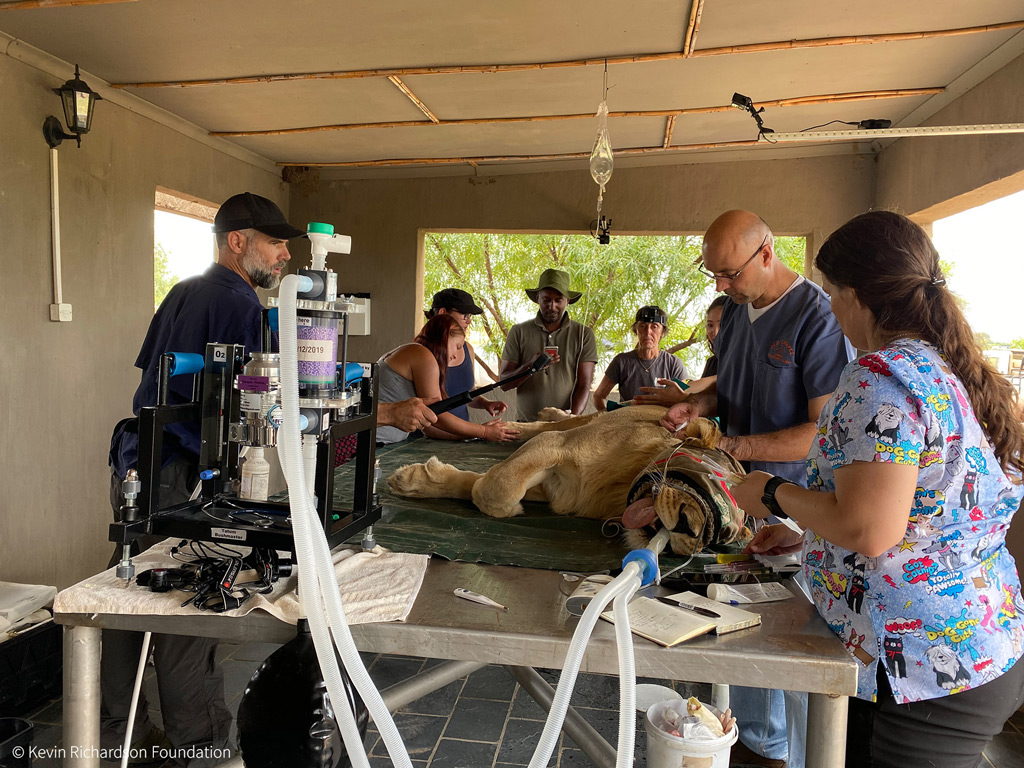
The summation that seeing images of interactions stimulates a specific commercial need is grossly oversimplified. Until Jane Goodall lived and interacted with chimpanzees, (as shown in the documentary 'Jane' past National Geographic), in that location was footling to go by in capturing the world's affection for these animals. We don't attribute the huge pet chimpanzee or monkey trouble to the many images of her or her colleagues interacting closely with primates – it'due south way likewise simplistic a correlation. What of Dianne Fossey, Liz Bonnin, Gordon Buchanan, Steve Backshall, Laurie Marker, Tony Fitzjohn, Linda Tucker and Gareth Patterson? What of all the new glory vets emerging so popular on social media and television receiver? Does seeing Sea Ramsay interact with a White shark make her followers, or people coming across those images, want to go shark cage diving? Many rehabilitation facilities show imagery of staff, visitors and celebrities petting giraffe, chetah, wolves, orphaned rhino and elephant. Do these images equate to people rushing off to ride elephants in Thailand or petting chetah at a roadside zoo? I don't think and so. If we are going to brand this correlation than we demand to agree anybody to the same scrutiny, as whatever image taken out of context can exist misunderstood. In the concluding ii decades, the widespread emergence of natural history and wildlife Telly shows as a competitive entertainment genre has turned many people into wildlife advocates. Would this have been possible without the interactions and relationships the presenters have with the wildlife?
I think these images and stories take helped millions of people to feel intimately continued to an increasingly estranged natural world. Some do it more ethically than others, but without bringing the animals into the home and heart of an audience, the disconnect betwixt humans and the natural world will go on to deepen.
Allow's not forget that 99.9% of people across the world will never footstep foot in a game reserve. Still, through our work, we have millions of people that feel personally responsible for the wellbeing of a species that is currently in peril, that they volition likely never run across in real life in the wild. I'm concerned that the idealism of those that insist that "hands-off" conservation is the only "correct" style, are those that a) are in the privileged position to visit national parks and go on expensive safaris, and b) are not in the ominous fiscal position of having to feed, care and maintain a home for these animals for a lifetime. As John Galsworthy aptly said, " Idealism increases in directly proportion to one'due south distance from the problem ".

![]() It would appear that none of your predators can exist released into the wild, so would you explicate how your connected interaction with them is to their benefit? Is it purely to ensure that they can be used for commercial purposes (such as the Tag Heuer advert) with minimal risks, thereby substantially paying for their own go along?
It would appear that none of your predators can exist released into the wild, so would you explicate how your connected interaction with them is to their benefit? Is it purely to ensure that they can be used for commercial purposes (such as the Tag Heuer advert) with minimal risks, thereby substantially paying for their own go along?
KR: Nosotros have released some hyena into the wild, but as many know, this is not viable with lions and leopard that were born and raised in captivity. At that place are fundamental reasons that I continue relationships with the lions. The first is that no thing how well cared for a captive brute is, I assure y'all, their lives are pretty dismal. The lions I care for, just similar other rescued lions, are essentially prisoners for life, confined to a pocket-sized space for crimes they didn't commit. They may exist thrown a ball, a toy or a blood popsicle hither and there as "enrichment", simply it'south no natural life no thing how you spin information technology. I'd similar to pose a question: If you lot were a bird in a muzzle, would you rather be left lone in your cage or would you rather have a relationship with your keeper and be released now and and so, to fly and feel like a bird? The lions benefit from the relationship nosotros have. When they hear my car coming, they will get up and run to the fence excited, for the stimulation our relationships bring nigh. Siam, one of the lions, will perk up in the midday heat (when a lion usually sleeps) and come to greet me. This is unusual behaviour for a lion. He wants his small moment in the day when he gets rubbed with citronella oil and brushed. When I see the happiness on his face, there is no way on earth I would deny him this small pleasure amongst the monotony of his existence. Last week I was sitting with some other lion, and as I e'er inspect them, I found a thorn in his foot that was going septic. If unnoticed, this would accept required the intervention of a vet and the trauma of existence anesthetised. My lions get a softer bear upon when it comes to veterinarian care – this is of immense benefit to them, and even when the vet does come up, their stress levels are much less due to our relationships.
I haven't spoken of this besides much, but information technology may help readers understand the relationship that exists between these lions and myself? Frequently when I go away on holiday, some of the more sensitive animals in the sanctuary become depressed. We accept a long history of animals getting ill when I am travelling abroad for long periods. This sometimes makes travelling difficult for me, equally I tin can never fully be nowadays where I am. Although difficult to talk about, one of my dear lionesses, Amy, died recently of leukaemia. She took a rapid turn for the worse over Christmas while I was away. When I returned, the vet and staff said she was waiting for me. I went into her enclosure and sat with her. She lifted herself, something she hadn't done since I had left, and uttered a 'wa-ow', a friendly, gentle, guttural sound that a lion makes when beingness appreciating. She died soon later on that. I don't feel the demand to convince people that there is a deep agreement between these animals and me; I know information technology to be truthful, and that is all. To ask me to terminate interacting with them is similar asking a person to please refrain from always hugging their child again.
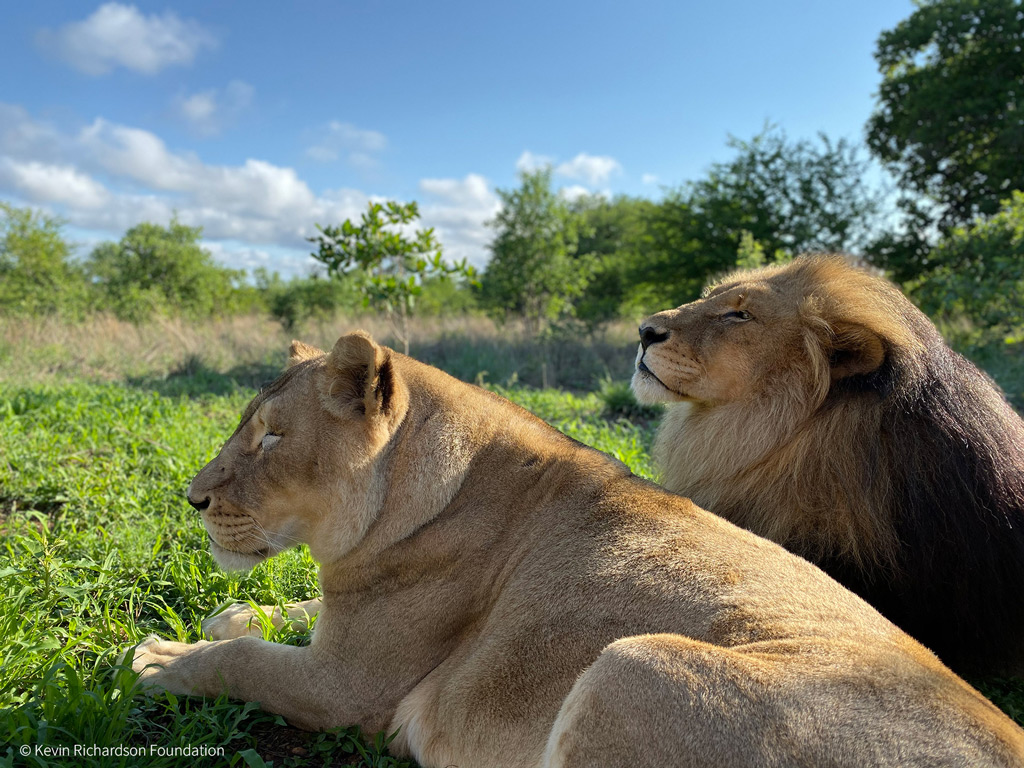
Regarding commercial opportunities such as the Tag-Heuer shoot, yes, these opportunities help create a ameliorate life for the animals, but I wouldn't frame it as a transactional agreement as laid out in the question. My motivation is my animals and looking after them in a way that tin exist more sustainable than the usual sanctuary approach, which relies entirely on donations and footfall through the door. My relationship with them has paved the way in creating unique opportunities, such as Wild Aid shooting a PSA for lion sensation and conservation, merely equally it does for Tag-Heuer that pays for some vet bills and the excellent care that these animals receive. To the lion, it'southward the exact same experience. The panthera leo doesn't care if the shoot is for an NGO or a brand – the lion is concerned only that it is enjoying the stimulation and the treats that come up with a shoot.
I facilitate many of these nonprofit shoots in big office, with no fee fastened, and the money goes to other NGO organisations. When I finally took ownership of these animals from the clutches of their previous owner, I had the freedom to exist very discerning almost which projects I accustomed, and each one is carefully considered. These shoots, Tag-Heuer included, take helped create a adventure-balky surround for me to fulfil my commitment to take care of these creatures for the residue of their lives. I call back with the release of the "Tiger Rex" docu-series, the world is waking up to the reality that information technology'due south a long, long, expensive commitment to house and care for a convict wild animal properly. You need to be smart and play the long game. My animals are getting sometime; I accept to exist prepared for rainy days. With the outbreak of the Coronavirus my telephone is going off the hook with other facilities asking usa to accept animals in because they cannot afford to keep them. I can keep my head above water during such times because of these shoots, and so I am very grateful for that and to the lions that assistance contribute to the upkeep of their kind.
![]() Your website mentions the support of the patronage of Her Serene Highness Princess Charlene of Monaco. What does this patronage cover and are in that location any conditions that you are required to follow to receive this support? If so, what do these conditions include?
Your website mentions the support of the patronage of Her Serene Highness Princess Charlene of Monaco. What does this patronage cover and are in that location any conditions that you are required to follow to receive this support? If so, what do these conditions include?
KR: My relationship with HSH Princess Charlene arose from her interest in spotted hyena. She wanted to help elevate the profile of hyena, and she visited me for advice. After spending time at the sanctuary, she became enlightened to the extent of how captive lions are being treated in this country. She has e'er wanted to help, and so when we were launching the foundation, I offered her a position of Patron which she accepted. The princess lends weight to our organisation and being South African, information technology was of import to her to represent an animal and so iconic to the country in her position of influence. There aren't specific atmospheric condition to her patronage, except that we provide her with our almanac written report and keep her abreast of what is happening legislatively. We are aiming to host a fundraiser in Monaco, only with COVID-nineteen and its detrimental impacts throughout the world we've had to button this out. As an organisation that is not yet two years one-time, nosotros need to strategically put resource into things that yield direct results, especially in the trying times we are all faced with.
![]() Did you buy panthera leo cubs from a breeding facility for Mia and the Lion? If not, where did the cubs for the movie come up from? If so, would this not qualify as supporting the industry you purport to condemn?
Did you buy panthera leo cubs from a breeding facility for Mia and the Lion? If not, where did the cubs for the movie come up from? If so, would this not qualify as supporting the industry you purport to condemn?
KR: We would adopt to look at the lion cubs from the film "Mia and the White Lion" as beingness saved from the abhorrent canned hunting manufacture. The fact that money exchanged easily has never been denied. I call back my critics enjoy the romantic notion that I did it secretly, hush-hush style. Acquiring the cubs was a calculated and intentional decision for a few reasons. Firstly, when we asked ourselves "Where tin we ethically purchase panthera leo cubs?" the resounding respond was… "Well, nowhere." I accept a strict no breeding policy at the sanctuary and was certainly not going to take a lioness off contraception to breed a few cubs that would readily exist bachelor at whatever one of the 300 breeding facilities in S Africa.
Secondly, the film for me was an opportunity to take a agonizing and horrific story and relay it to audiences across the world in a palatable style – through a family film. I take worked in conservation and documentary moving picture for over 2 decades. I've come to understand that the audition that seeks out betrayal' blazon films is generally the audience that is already quite informed. Information technology certainly excludes children, as we want to protect them from seeing these horrific images of lions being slaughtered, just every bit nosotros protect them from seeing what transpires at feedlots, chicken farms and piggeries. I believed the film to be an effective and modern way to spread this story globally. The film required lions, and I knew I could help make the film happen. My question to the reader is, would not acquiring the cubs, and not making the movie, take served the cause of lions in any way? I question the power of boycotting in this circumstance. If I had not acquired cubs and non made the flick, nothing would've transpired. Past procuring the cubs and making the picture show, a doorway to millions of people has been opened, and awareness about canned lion hunting become known where information technology was previously unknown. For these few lucky lions that escaped the bullet and now live in my sanctuary, this choice served them well as well.
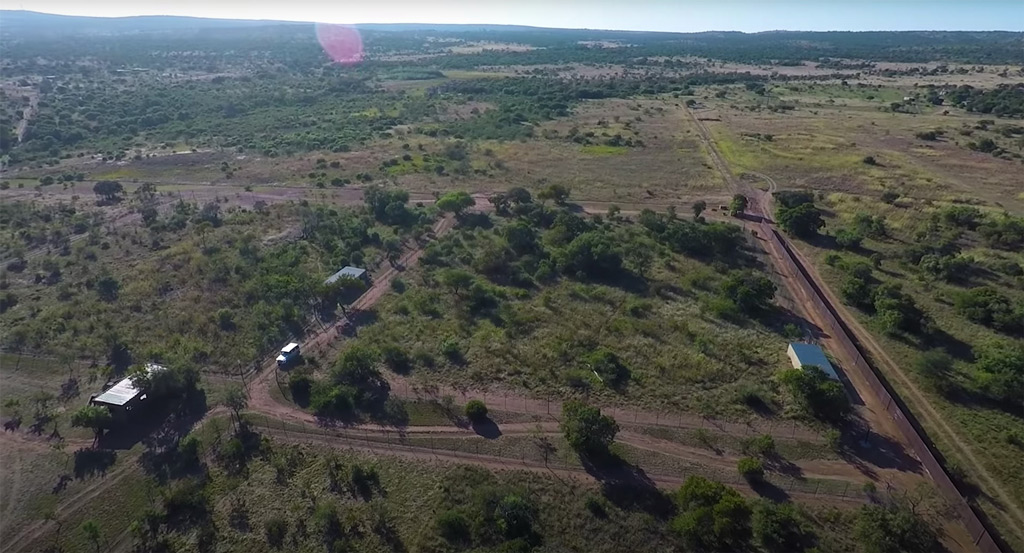
Does it qualify as supporting the industry I condemn? The reply to that is subjective, in my opinion. I paid considerable sums to become ownership of all the lions in my intendance – every bit they certainly weren't going to be handed over as a gift – too much an amount for a grouping of ageing and in-bred lions to be honest. You can call it rescuing or purchasing… in that state of affairs I felt I was paying a bribe for animals I had grown to know and dear. Information technology amazes me that people get hung upward on this. To do an exposé on man trafficking, a filmmaker may demand to solicit a sexual practice worker for an interview, supporting an industry they are against. Many organisations are founded on the purchasing of lions, like Panthera Africa, for example, as told in the book "Cuddle Me, Kill Me" past Richard Peirce. No one hides that fact, and everyone agrees that Obi and Oliver were rescued, even if they were purchased. I recollect the idea that paying money for something that serves a college purpose is the same every bit "supporting" an industry they disagree with is a scrap far-reaching and lacking in creativity and foresight.
![]() How many predators practice yous have at the sanctuary, and would you be willing to explicate the background of all of them?
How many predators practice yous have at the sanctuary, and would you be willing to explicate the background of all of them?
KR: I accept 24 lions left in the sanctuary, and that number is decreasing year on yr as they historic period and dice. Virtually of the lions are well over 12 years erstwhile, many 15, xvi and 17. At that place are also iv leopards, 11 elderly spotted hyena and two striped hyenas. The background of these animals is that I came to know them while working at Panthera leo Park as a immature man in the belatedly xc's. When I severed all ties with The Lion Park, I took these animals with me, and it took me several years to get legal ownership of them. This background excludes the half-dozen lions acquired for the film "Mia and the White Lion", which has been explained above, as well as George and Yame – 2 lions rescued from Spain by The Entrada Against Canned King of beasts Hunting (CACH) who asked if I would take them.
When the final lion passes, these enclosures will either come up down and become office of the habitat around it or be used as a temporary rehabilitation facility for wildlife that is injured and will be released into the wild. This era of my life will be over, and I volition appoint with the new earth of conservation that emerges and the new challenges that it brings.
![]() You referred to the Tiger King series currently viewing on Netflix. What are your thoughts about the series?
You referred to the Tiger King series currently viewing on Netflix. What are your thoughts about the series?
KR: Having now watched it, I can say I am honestly stupefied at both the way the animals are existence kept and the people who appear in this evidence. Although I have always been aware of the horrific numbers of big cats kept in backyard conditions, poorly run zoos and rescue facilities in the United statesA, it was horrifying to get an within expect at the sheer calibration of what is going on, not to mention the motives behind the people 'caring' for these animals. What was specially disturbing was the millions of dollars (some donated), squandered on frivolous lawsuits and personal rivalries. It shows that even big cat rescue centres that are lauded equally ethical have lost affect with their priorities. It seems, in this example, the fish is rotting from both ends. Although the reality is worse than I ever imagined, it is necessary and positive that the whole globe is now aware of how ludicrous the situation is and how much harm is being caused by lack of regulation. Hopefully, this will give rise to some legislation change that makes the ownership and breeding of wildlife more restrictive. For years I have been explaining to people the considerable responsibleness and complexity involved in adequately caring for predators in captivity, and that it is a lifetime commitment that requires shed loads of money. I hope the series is a warning to those individuals who can't see past the few months of when a cub feels similar a cute pet, and goes out and buys a predator cat on a whim. When it comes to beast welfare, it's heartbreaking to see the conditions these animals have to endure, but sadly there are just as many large true cat rescue facilities (initially with good intentions to 'save') that are every bit bad, if non worse, than some of the zoos or circuses the animals accept been "rescued" from. What worries me is that these facilities, dependent on the public to keep running, are existing hand-to-oral cavity, with no contingency program and what happens now to the animals in a scenario such as the COVID-xix outbreak? As I write this, these facilities are airtight with zero income during the lockdown, what of the animals?
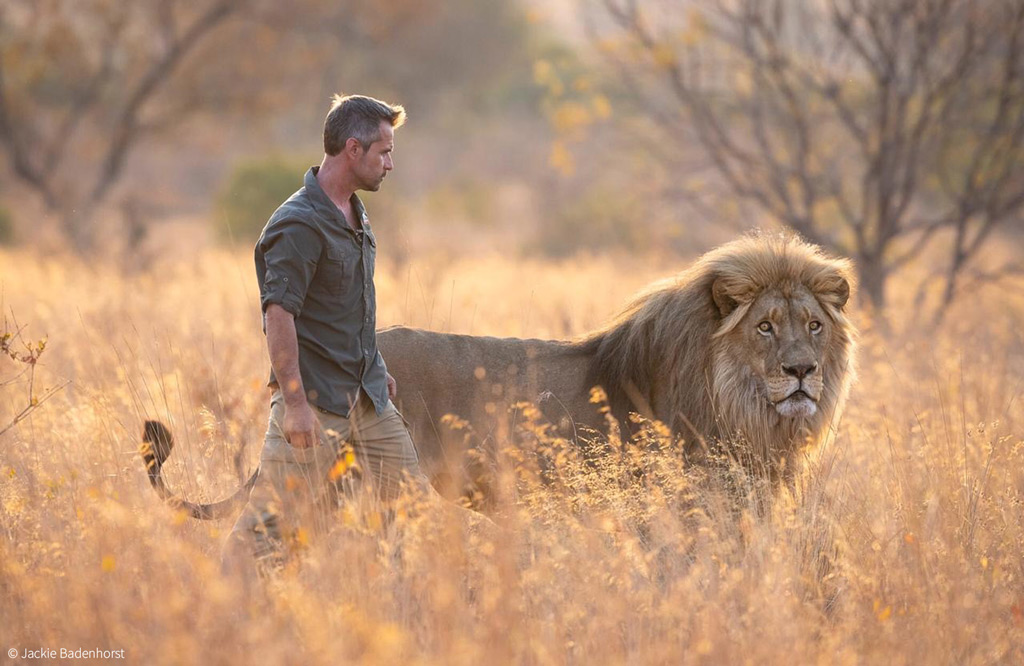
To comment on this story please join our PRIVATE TRAVEL & CONSERVATION Gild. Run across details below.![]()
HOW TO Become THE Almost OUT OF AFRICA GEOGRAPHIC:
Source: https://africageographic.com/stories/kevin-richardson-the-lion-whisperer-hard-questions-and-frank-replies/
Posted by: mckinleywriney.blogspot.com

0 Response to "How Has Our Relationship With Wild Animals Changed Since The Time Of Colonel Patterson"
Post a Comment